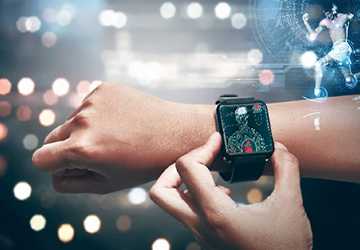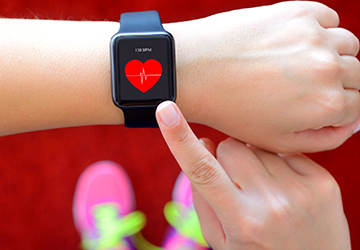How Wearable Technology Is Revolutionizing Health Monitoring
In a world where our smartphones seem almost glued to our hands, it’s no surprise that technology is finding new ways to stay closer to us. Wearable technology has swiftly transitioned from a niche gadget to a daily essential for many. These devices, from sleek smartwatches to innovative fitness trackers, are not just about counting steps or tracking sleep anymore.

What if technology could become even more integrated into our lives, not to distract us but to empower us to take charge of our health? This is the promise of wearable technology, a trend that has transformed from a fad to a daily essential. Wearable technology in healthcare is becoming a powerful tool that provides real-time insights into our health, offering a glimpse into a future where staying healthy is as simple as wearing your favourite accessory.
Let's examine the impact and advantages of wearable technology.
Wearables: Beyond Steps and Sleep
Remember those clunky pedometers our parents clipped to their belts? Wearable technology has come a long way since those early days of simply counting steps. Today's wearables have evolved into sophisticated health monitors, seamlessly integrating into our lives and offering a wealth of data about our well-being. These devices have various advanced features that can provide in-depth insights into our health. Here are just a few examples:
Heart Rate Monitoring
Many wearables come with built-in heart rate sensors, allowing you to track your heart rate throughout the day, during workouts, or even while you sleep. This information can be valuable for understanding your fitness level, identifying potential heart problems, and monitoring your stress response.
Blood Pressure Tracking
Some advanced wearables can now even track blood pressure, which can be particularly beneficial for people with hypertension or those at risk of developing the condition. By monitoring blood pressure trends, individuals can work with their healthcare providers to manage their health more effectively.
Sleep Tracking
Monitor your sleeping patterns, including sleep stages (deep sleep, light sleep, REM sleep) and duration.
Blood Oxygen Measurement
Estimates the amount of oxygen in your bloodstream, indicating overall health and fitness.
GPS Tracking
Tracks your movement and distance travelled during workouts or outdoor activities.
Activity Tracking
Monitor your daily activity levels, including calories burned and active minutes.
Stress Monitoring
Analyzes physiological data to estimate your stress levels and help you develop coping mechanisms.
The Power of Real-time Insights
One of the most significant advantages of wearable technology is its ability to provide continuous health data. Unlike traditional methods that involve sporadic check-ups or measurements, wearables collect data throughout the day and night, painting a much more comprehensive picture of one's overall health.
Imagine a scenario where you don't just get a heart rate reading at your doctor's appointment, but you have access to a record of your heart rate throughout the day, during exercise, and even while you sleep.

This real-time data holds immense potential for the early detection of health issues. By monitoring key metrics like heart rate, blood pressure, and sleep patterns, wearables can be changes that might indicate health problems. For example, a sudden rise in resting heart rate or a significant change in sleep quality could be early warning signs that warrant further investigation by a healthcare professional.
The Best Wearable Technology Products and Examples
Here's a rundown of the famous wearable tech examples:
Smartwatches
These wrist-worn computers do more than tell time. They track fitness, receive notifications, make payments, and even control smart home devices. A famous example is the Apple Watch.
Smart Wearables
Think earbuds or headphones with extra features. These can offer active noise cancellation, health monitoring, voice assistant integration, and real-time language translation. A famous example is the Sony WF-1000XM4.
Fitness Trackers
These wearable bands focus on health and wellness. They track steps, heart rate, and sleep patterns; some even offer GPS for outdoor workouts. A famous example is the Fitbit Charge 5.
Smart Glasses
These aren't just for virtual reality anymore. AR glasses overlay digital information onto the real world, while some smart glasses offer basic functionality like displaying notifications or playing music. A famous example is the Google Glass.
A Glimpse into the Future: Wearables Woven into Wellness
The future of wearable technology is brimming with exciting possibilities. Imagine a world where your health data is constantly monitored in the background without any conscious effort on your part.
Wearable technology in healthcare could evolve into comprehensive health management tools, working with healthcare providers to offer personalized recommendations and preventive measures. For instance, your wearable might detect a dip in energy levels and suggest dietary adjustments or stress-reduction techniques.
Conclusion
The impact of wearable technology cannot be overstated. It has rapidly transformed from a fad to a daily essential, redefining how we monitor our health. Gone are the days of simple step trackers; today's wearables offer a wealth of features, from heart rate monitoring and blood pressure tracking to sleep analysis and stress detection. This continuous stream of health data helps to identify potential issues before they escalate.
The future of wearable technology is brimming with potential. As these devices become a significant part of our lives, we can expect them to play a transformative role in healthcare. They have the potential to not only monitor our health but also motivate us to lead healthier lifestyles through personalized feedback and gamified challenges.